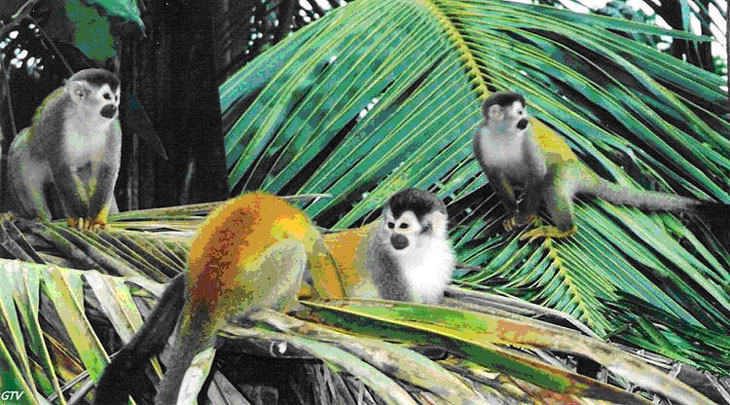|
|---|
Titi Monkey Breakfast Club “Really George, Can’t We Call This Meeting to Order?” |
Broken News
Starbuck's Entrada
Starbuck's opens its first Costa Rican coffee shop in the affluent San José suburb of Escazú this month.
 |
|---|
A Starbuck's "Barista" or Coffee Maker/Server |
You wonder what took Starbuck's so long considering the company has been buying large quantities of Tico coffee beans here for years. Last year more than 1500 hectares (almost 4,000 acres) were devoted to Starbuck's beans and that land produced 3.2 million kilos (almost 7,000,000 lbs) for the company.
The hesitancy in opening a coffee shop may be a smart strategy for Starbuck's because good coffee here is cheap and most locals are reluctant to pay $3-4 for a cup of enhanced coffee. Most Ticos drink their java plain or with a little milk and sugar. It may take some time to corrupt,,, er, educate locals on loading their java with artsy-fartsy stuff.
Will the Ticos take to the upscale elaborate mixtures on which Starbuck's likes to make their money?. Are they likely to order a iced caramel macchiato or a cinnamon dolce frappacino, for example? We'll see. I suspect that's why the company decided on Escazú for their first shop, The area has a large American ex-pat population (one might say it's the American ghetto of Costa Rica) who might be more inclined to go for the Starbuck's offering and pay the enhanced price gringos are used to paying. If the Gringos set an example, maybe the Ticos will catch on.
The new shop is expected to be, or at least hoped to be, only the first of many under the strategy adopted by Starbuck's Central American Division based in El Salvador. Perhaps we'll see one in Quepos/Manuel Antonio in the not too distant future. Why not; we've gotten a Subway in the last year and rumors have it we're getting a Burger King and Domino's Pizza soon. Civilization is finally encroaching on our area. Bueno.
(Bienvenidos) Welcome to Costa Rica, Starbuck's!
Quivering Nicoya
As reported here frequently. Costa Rica sits on a convergence of tectonic plates that formed the thin isthmus now known as Central America. Accordingly, significant earthquakes happen here all the time.
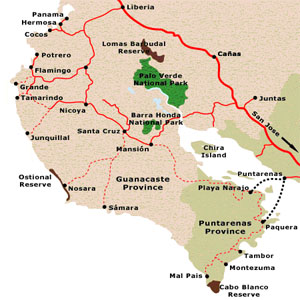 |
|---|
Nicoya Peninsula - Northwest Costa Rica |
Forecasting an earthquake has been a near impossibility for eons, but now some scientists are beginning to predict major ones to come. Costa Rica alone has several hundred monitoring stations and the sensitivity of the latest technology is beginning to allow the tech dudes to measure the buildup of pressure on the tectonic plates.
Scientists from the Observatorio Vulcanológico y Sismológico have been holding community meetings on the Nicoya peninsula because they expect a major quake to take place there that will run through the middle of the Gulf (that's the inland bay shown on the map to the right). The area has been more active recently with dozens of tremors in the 3.0-4.0 range.
The scientists expect the entire peninsula to shift so that one coast subsides and the other is raised higher above sea level.
I presume they're talking about the East and West sides of the peninsula but the OVyS dudes have not yet taken the plunge to let us know which coast is likely to dip or by how much (wouldn't it be nice to know if your property is soon likely to have either a Santa Monica or Seaworld view).
The scientists base their predictions on previous quakes in records going back to 1827. There have been four 7.0 magnitude or better quakes in and around the peninsula since 1950 That's one every 15 years. The last was March 25, 1990 some 22 years ago.
Sounds like the people in the Nicoya are overdue for a tremblor. Hold on to your knickers, Nickies..
Burn Judas Burn
Easter (La Pascua) was celebrated April 8 here, preceded by that horrific... er I mean intense week they call Semana Santa (Holy Week).
The official (constitutionally adopted) religion here is Catholicism although there seems to be a great tolerance for other religions such as a variety of fundamentalist or evangelical sects. In my neighborhood alone we have a Jehovah's Witnesses Kingdom Hall, a fundamentalist bible church called Luz del Mundo (Light of the World) and another church of unidentified affiliation or concept. They all seem to be flourishing.
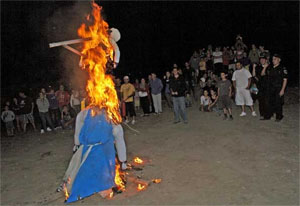 |
|---|
That'll Teach Ya Judas |
There are many religious traditions among the Catholics here. One of the strangest or at least most interesting tradition is La Quema de Judas or the burning of an effigy of Judas during the Easter period. I'm not aware that this practice actually occurs in Quepos, but there are reports that it is still a fairly common practice in the environs of San José. I hope to see this party some day - does one bring wieners and marshmallows?
There was a report that the U.S. State Department at one time had labeled this tradition as anti-semitic. Bull frogs, you bureaucratic dudes; it's simply anti-Judas symbolism.
In contrast to Costa Rica's tradition of religious freedom, the following report about Cuba was printed recently in an English-language journal here: "As a result of the Pope’s visit to Cuba and his meeting with government and religious leaders, Raul Castro declared Good Friday a new national holiday (gee, thanks R). Catholics will be able to conduct the traditional Via Crucis (Stations of the Cross) solemn processions in La Habana. Religious processions and pilgrimages were outlawed in Cuba back in 1961. Eight years later, Fidel Castro became a real-life Grinch as he took Christmas away from Cubans by declaring that December 25th was no longer a national holiday" (bah, humbug F). Both holidays were reinstated when Pope John Paul II visited the island in 1998. The commies weren't able to eradicate Christianity in Russia either.
On a more secular front, Semana Santa means a long vacation for many Ticos as Holy Thursday and Good Friday are mandated, paid national holidays and many Ticos take the whole week off. The onset of Semana Santa is a signal for muchos Ticos to abandon the big city and inundate the shore areas with their presence, particularly the Nicoya, Jacó and Manuel Antonio. This is the only time of the year GG avoids the beach. From Wednesday to Sunday of Easter week the tree line at Playa Espadilla is crowded with pup tents, blaring radios (Ticos love their music at 110 decibels) and consumption of umpteen bottles of cerveza to lubricate a myriad of loud conversations.
It's also a good time to be extra alert on the buses as the ladrones (thieves) come along with the crowds and some unsuspecting visitors may find themselves relieved of their wallets or cell phones. particularly on the overloaded buses (unfortunately, this happened to our hero recently). As a martial arts friend of mine says, use the four "A's": "Be aware, alert, anticipate and take action if necessary".
That's OK my Tico amigos, enjoy yourself at the beach. I can wait until the end of Semana Santa to get back to bikini patrol.
¡Pura Vida!
Museo Nacional
Prior to the onset of Semana Santa, our hero took a couple of days off (with a retired person, this phrase is used rather tongue in cheek) and went to the big city of San José for diversion.
The first order of business for a refugee from Quepos/Manuel Antonio when visiting Chepe (cheh-pay: a colloquial reference to the Big SJ) is to buy something one just can't get in a small town like Quepos. I meandered the walking streets such as Avenida Central and Avenida Segunda and, surprisingly, couldn't come up with one item I needed, or even wanted.
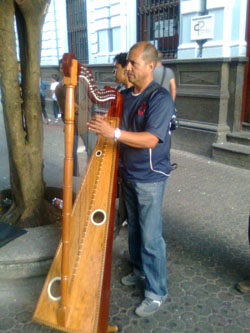 |
|---|
Not Your Usual Panhandler |
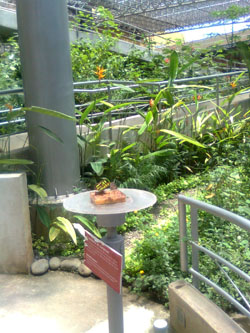 |
Butterfly Garden Entrance to Museo Nacional - A Couple of Butterflies are Shown Feeding on a Sweet Treat Left by the Caretakers |
I had been searching for a back brush for the shower on the previous trip (a manly bristle type, not the fluffy female type) and couldn't find one even in a well known Costa Rican version of Bed, Bath & Beyond in the Ezcazú Mall. But I had placed an order for the brush, some Gillette Fusion razor blades and a certain printer cartridge with a friend of mine from the States who's coming to visit about the time this issue will be published, so I didn't need SJ for those either.
Shopping this trip turned out to be aimless wandering but I did find the harp player with his home-made instrument (photo left) on Avenida Central interesting and the roaming around did provide the opportunity to stop at the Pops ice cream parlor near Plaza de la Cultura more than once for a double cone of their rich helado. Not available in Quepos, this is the best ice cream in Costa Rica in my opinion..
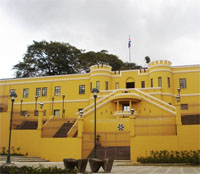 |
|---|
Entrance to Museo Nacionál |
The next day a friend and I visited the Museo Nacional or National Museum of Costa Rica. This neo-classical building spans a whole block between Avenida Central and Avenida Segunda and is located about three or four blocks east of the National Theater in the heart of San Jose.
This old building was a fort and army barracks for many years prior to the modern era of Costa Rica, which began in 1948 with the establishment of the current republic. The building is complete with turrets containing slots for rifles and cannonade. The fort played an important part in the civil war battle of that year and there are still hundreds of bullet holes plainly visible about the outside walls that were left to remind citizens of the war.
Also, there is a plaque on an internal wall commemorating the end of the war in 1948 and the beginning of the constitution along with the then-President Figueres pronouncement that Costa Rica would have an army no more.
Inside this traditional Spanish-style courtyard building, you will find displays on Costa Rican history and culture from pre-Columbian times to the present. I must say I've never been very impressed by pre-Columbian (read pre-Spanish) stoneware and pottery shards and so I passed through this section rather quickly. Having been so cavalier, I was later told I missed a famous 2,500-year-old jade carving that is shaped like a seashell and etched with an image of a hand holding a small animal. Sorry amigos, next visit I'll be sure to see it.
Besides the plaques and displays about the fort and the exhibit on life in the fort, there was a temporary but extensive exposition of the photographic works of Francisco Coto, a man who saw and covered the entire modern era of the country in pictures. Also, there are a number of those famous stone spheres in various sizes that the Chronicles reported on last month and which later I would write a book about, Las Esferas.
But what I found the most impressive about the museum is the internal entrance to the display areas. After paying the $8 entrance fee, you step into an open, two story, screen enclosed butterfly garden of tropical plants and fluttering mariposas all around (see photo above). You wind your way up a slow ramp that doubles back across the room several times until you reach the second floor. You will encounter beautiful blue morpho butterflies as well as many other species as you walk through the greenery. There's a small feeding station where a sweet treat is laid out by the staff to attract the butterflies down to floor level. I can't think of a better way to start an exposition of Costa Rican culture than that room.
So, if you find yourself in downtown San José looking for something to do or need to kill time, check out the Museo Nacional. For you bus travelers from Quepos, it's only 9 quick blocks walking north from the Tracopa bus station (or take a quick taxi).
¡Solo Bueno!
Busing Around
Let's suppose for a moment that you do not have a personal or rental automobile and that you expect to circumnavigate San José and the rest of Costa Rica without one. It's not that difficult to do by bus but there are a few tricks to making it a more pleasant experience. But first, the taxis.
San José
Taxis in San José are all over the place and so are easy to find. Almost all taxis have meters and most of them are calibrated to the official rate. If you don't see a meter you should ask the driver if he has one (some are small and not obvious) or ask for a quote to where you're going. Costa Rica is no different than many countries and taxi drivers can be opportunistic, but most SJ taxis follow the rules. You can get around the centro area by taxi for under 1,000 colones ($2) while going across town might take 2-3,000 colones. Taxis to the outlying areas such as Alejuela, Heredia and the main airport from downtown can cost $20-30.
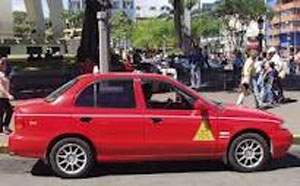 |
|---|
Regular Taxi With Triangle Medallion |
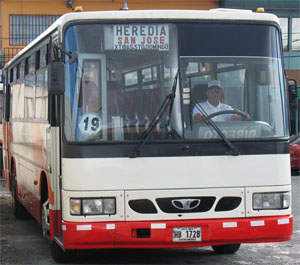 |
| Typical San José Bus, This One to Heredia |
Regular taxies in Costa Rica are easily distinguishable by their red color and the yellow triangle painted on their side. The triangle contains the taxi number (three or four digits) and the code for the region for which it's licensed (six digits). The medallion assures the passenger that the vehicle has been licensed, inspected, insured and (should be) operating with a meter.
Also, there are pirate taxies ("piratas" or "porteadores") that operate outside the regular system. This is particularly true in places like Quepos but there are some in San José also. A few of them are red or may be standard car production colors but none have the triangle. Locals here in Quepos use piratas all the time and know many of the drivers, but be aware they can be unlicensed, uninsured and sometimes poorly maintained.
San José buses run often and to virtually every bario in the city. If there is a comprehensive written bus schedule for local city buses, it's been held as a closely guarded state secret.for years. Many buses start or finish their routes near the so-called Coca Cola station in the West-Central section of the city (named, I'm told, after the company of the same name that used to have a plant there). But some routes (Alejuela, Heredia, Cartago for example) start from as many as six or seven blocks from the Coca Cola. You just have to ask someone who knows.
Most buses can be picked up at a bus stop anywhere along their route. Bus stops are (mostly) marked at the curb in a yellow strip painted on the pavement containing the letters "C.T.P." (Consejo de Transportes Publico or Public Transportation Council). Many stops have a tell-tale rain shelter that distinguishes them. The stops are rarely separated by more than a quarter of a mile and the bus driver relies on passengers to press the button or pull a cord to signal when you want to get off.
San José buses are very inexpensive, ranging from 150 to 250 colones (30 to 50 cents U.S.) for most downtown venues and up to 460 colones (less than a buck) for the farther out suburbs such as Heredia or Alejuela.
In addition to local buses, longer haul buses to virtually every part of Costa Rica and even countries to the north (Nicaragua on up to Mexico) and to the south (Panamá) can be purchased in San Jose or even in Quepos. Ticket offices for the long hauls are in different places for different routes (ask amigo, keep asking). The long hauls can cost up to $50 or more depending on the country, the distance and the type of bus taken (regular or executive).
Quepos/Manuel Antonio
To get to Quepos/Manuel Antonio from San José.by bus, the current terminal (called Tracopa)) is located at Plaza Viquez, which is at Calle 5 and Avenida 20 or 5th Street and 20th Avenue. Yes, unlike Quepos, San José actually numbers their streets, although most cabbies still prefer the Daniel Boone method of navigation. The cabbies are more likely to know Plaza Viquez first, the Tracopa terminal second and 5th and 20th address a distant third.
There are two types of buses - Collectivo and Directo. Collectivo is a term the bus company uses to describe a bus that diverts through and stops in many towns and villages along the way. The Collectivo can take up to 4 1/2 hours to reach Quepos and is normally taken by people who might live in one of the villages off the expressway or want/need to save the 700 colone fare difference between the Collectivo and the Directo.
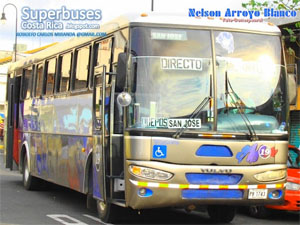 |
|---|
|
The "Directo" to Quepos/Manuel Antonio
|
The Directo usually takes less than three hours to reach Quepos from San Jose and the same is true for the return trip. The Directo has only two scheduled stops, one at Parrita (14 miles north of Quepos) to pick up or discharge passengers, and one at Orotina, for a nature and snack break. The Directo may also stop a few times as it approaches its final destination to allow people to get off closer to their homes but, unlike the Collectivo, the Directo never leaves the main highway.
The current fare for the Directo on the Quepos/San José run is 3,900 colones or just under $8. The Collectivo, as mentioned above, is about 700 colones less.
Unfortunately. information on when what bus leaves for where is also sorely lacking in Quepos. Only a limited schedule is posted, for example, to Puntarenas and the Directos/Collectivos to San José but not for all the other buses that leave from there. Even then, there are little secrets that "one is expected to know", for example:
- The Collectivo for San José always leaves from Quepos station on the appointed hour.
- The Directo leaves from Manuel Antonio Beach on the appointed hour and approximately 15 minutes later from the Quepos station (the first time I took it I thought I had missed the bus)
- The Directo no longer stops at the airport because it now travels via the new autopista and avoids the old mountain road. Arriving in San José you either have to take a taxi from downtown San José and back track the 15 miles or so to the airport or take a private van/taxi (below) from Quepos which will disembark you at the airport.
- Similarly, you can not pick up a Quepos bound bus at the airport; you need either to take a taxi or bus to the Tracopa terminal in San José (expensive and time-consuming) and then take a Quepos-bound bus from there or take a private bus/van (below) such as Interbus which leaves from a terminal only about 1 mile from the airport (you'll need to take a short taxi ride from the airport to the Interbus terminal).
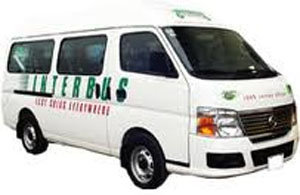 |
|---|
|
Interbus - One of the Private Minibuses
|
To get to or from Quepos to the airport by bus, the easiest way is to take one of the private minibuses run by Interbus or Grayline that have terminals near the airport and in Quepos. They will pick up and/or deliver you to your hotel here or even your home (shhh - with a little tip). The fares are $40-45 one way but having to navigate the bus/taxi alternative mentioned above would cost nearly the same and that's a lot more work. Both companies take reservations online; here are the links: (Interbus) or (Grayline).
There are regular local buses available at the main Quepos station to nearby communities such as Parrita, Naranjito, Londres, Villanueva, Dominical, Uvita, San Isidro and even Puntarenas. These buses are "collectivo" in the sense that they will let you off wherever you or anybody else rings the stop button. For example, the bus on the way to Londres will stop in Naranjito, the Uvita bus will stop in Dominical and the Puntarenas bus will stop in Jacó as well as a number of points between these cities. Be aware that you will probably be required to pay the fare for the whole route even if you get off early.
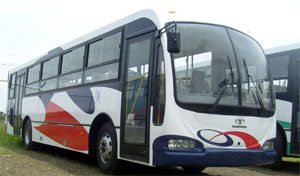 |
The Quepos/Manuel Antonio Bus |
The final bus of interest here and the most important for short travel in the immediate area is the Quepos to Manuel Antonio route. This route runs about 7 kilometers (a little over four miles) from the main Quepos station through part of the town and the full length of the Manuel Antonio road. The bus then turns around at the National Park and returns to Quepos.
Going from Quepos central station, there are approximately 18 stops along the route: Quepos Football Field, Invu, MA Surfing School, Bamboo Jam, Mono Azul, Hotel Gaia, Amigos del Rio, Tres Banderas, MA Football Field, Pacifico Colonial, Cafe Milagro, Si Como No, El Avion, Coste Verde, Cabinas Piscis, Mar Y Sombra, Marlin Restaurant and the National Park (not that I've ridden this route many times and know it from memory). That's an average of slightly less than a quarter mile per stop. Remember, the bus will only stop if there are people waiting to get on or someone has rung the stop buzzer ("toque el timbre", amigo). If you do not know what stop to take, simply tell the driver what restaurant or hotel you're looking for when you board; there's an 80% chance that he'll remember.
During the high season these buses leave the Quepos station every 15 minutes and off-season, maybe every 20 or 30 minutes depending on how off season it is. Also, the number of buses thins out after dark, running only one per hour after 7 PM. The last bus leaves Manuel Antonio at 10 PM. If you get stuck or can't wait, there's always a taxi hanging around somewhere but be sure to ask for a quote if no buses are running as the taxi drivers know when the buses run and the taxistas can get opportunistic in the off hours.
Bus fare for the Q/MA bus is 250 colones or about 50 cents U.S. whether you make one stop or go to the end. In the old and simpler days, buses on this route could be waved down anywhere along the route - some of the older travel guides still say you can do that (not). No more amigos, the drivers expect you to walk to the nearest bus stop but every now and then they'll make a stop off-mark if they're feeling kind (doesn't usually happen for tourists, but they may stop for the elderly or pretty girls).
One thing I forgot to mention is that Costa Rica buses pretty much run on time. The latest I've ever been on a departure is 15 minutes and that was a long haul where it didn't matter much. So if your travel plans call for a dependable and economic way of getting around, consider the Tico bus system amigo, it works.
Juan Santamaría
If you're like me, when someone uses the term "filibuster" you immediately think of a windy congressman talking on and on until the proponents of a legislative bill give up because they can't get a cloture vote.
 |
But it turns out that there has been another meaning of this term in the history of both the United States and Latin America. Here's the dictionary definition for the other use of filibuster, according to Miriam-Webster:
”An irregular military adventurer; specifically, an American
engaged in fomenting insurrections in Latin America in the
mid-19th century.”
Whodathunkit? So, an unofficial American adventurer bent on creating mischief in Latin America (excluding this writer of course) is a "filibuster". The origin of the word is given below in the What's-in-a-Word section.
It seems it all goes back to before the U.S. civil war when prevalent thinking in the U.S. amongst the boys in Washington was that the U.S. might run out of resources some day (drill, baby drill) and territorial expansion of the republic was encouraged, albeit unofficially. Some labeled this policy "Manifest Destiny". Manifest Destiny encouraged Americans to look for opportunity beyond U.S. borders, with the intention of bringing riches back to the homeland as well as possibly annexing new territory. The policy was well understood but got no official support from the government (they could always say George Bush did it).
When a fellow from Nashville named William Walker, a Philadelphia lawyer and doctor by education and training and a mischievous scoundrel by instinct and desire, heard the call he abandoned his lifestyle and organized his first military expedition, this time to California where he proclaimed himself President of California. He was greatly ignored and kicked out of the territory, so he headed south with his army known as the "Immortals" . He overthrew the government in Nicaragua and proclaimed himself Emperor of Central America (humility was not one of Billy's character strengths).
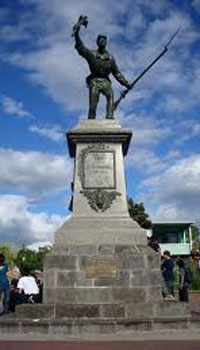 |
|---|
Juan Santamaría National Monument in Alejuela |
Well, as might be expected. latinos here did not take kindly to supposedly being conquered by a gringo upstart. Several central american countries organized joint forces to oppose the Emperor, including Costa Rica.
The most famous battle of this war was held at Rivas, Nicaragua on April 11, 1856. Under the direction of the Salvadoran General José Maria Cañas, a young Costa Rican lad named Juan Santamaría volunteered to set the enemies barracks on fire, after extracting a promise from his superiors that his mother would be cared for should he perish. Santamaria succeeded in his mission but was mortally wounded and soon died. He was 25 years old.
The deed turned the battle in favor of the Centroamericanos and Walker was routed. He was later caught in Honduras and executed by that government in 1860. (Ya shouldda stayed a Philadelphia lawyer, amigo, their hanging rate is somewhat lower than a filibuster)
April 11 is now a paid national holiday here and Juan is honored as a national hero. Monuments to Santamaría have been erected all around the country and particularly in his home town of Alejuela. The largest international airport, located in Alejuela, also bears his name and a statue. Folk songs have been written about him:
"Juan Santamaría, nació in Alejuela, tan pobre vivia que no fue la escuela..."
(Juan Santamaría, born in Alejuela, lived so poor that he didn't go to school...)"
That's OK Juan, you were there when your country needed you, amigo.
What's-in-a-Word
Buena Nota
This is probably the most used exclamation after ¡Pura Vida! and is often used in the same way, to express approval or note good work or good news. "I got a 95 on my test, amigo!" says the student. "Buena nota"! says his friend. Likewise, you also use "Mala Nota" to express the opposite reaction.
Filibuster
As mentioned in the article above on Juan Santamaria, in the middle of the nineteenth century different bands of adventurers organized in the United States were in Central America and the West Indies stirring up revolutions. Such an adventurer came to be known in English as a filibuster, from the Spanish filibustero. The word had originated in Dutch, as vrijbuiter ("freebooter"). How the word got from Dutch to Spanish is uncertain, but it is likely that the Spanish borrowed the word from the French, flibustier, who apparently got it from the English freebooter. So, it turns out to be a great Dutch-Spanish-French-English word.
In the nineteenth century, the use of delaying tactics in the U.S. Senate (yes, Dorothy, they were doing that back then also) frustrated so many that some Senators compared the intransigent orators and stonewallers to adventurers, i.e. filibusters. Over the years the word came to mean “obstruction of legislation in the U.S. Senate by prolonged speechmaking” after a congressman described one such obstruction as “filibustering against the U.S.”
ROMEO Corner
(Retired Old Men Eating Out)
Puerto Escondido - Manuel Antonio
To see the latest review on this restaurant, go here: Escondido - April 2015
Location: Across the Street from The Villabosque Hotel (From the Main Road to the National Park, Turn Left at the Marlin Restaurant, Go 200 Meters, Turn Left at Hotel Villabosque and Go Straight Another 50 Meters. The Restaurant is Part of the Hotel Espadilla)
Hours: 7 AM to 10 PM Sunday Through Monday
Parking: Ample at the Restaurant and the Hotel
Contact: Tel.: 2777-0903; Fax: 2777-5052; Email: hotel@espadilla.com; Web: www.espadilla.com
Reviewing ROMEOS: Alice Lee S., Joanna K., Brent F., Brian M., Bob N.
Puerto Escondito or "Hidden Port" is a good name for this restaurant because it's off the beaten path and tucked into a jungle hideaway well removed from the hustle and bustle of Manuel Antonio beach, although there is no "port" or water to be seen anywhere. Several of us who have lived here and/or visited here for years never heard of this place until recently. One of the ROMEO's had stayed at the nearby Hotel Villabosque in the past and brought the Puerto Escondito to our attention. For that we thank him.
The dining room is a large square with maybe 15 tables and is thickly surrounded by palms and banana plants so that, while open to the atmosphere, the room becomes a private and intimate part of the jungle The lighting is soft, perhaps too soft for the average old dude to read the menu easily, but unlike a lot of restaurants in this area that have low lighting, this one provided us with a small flash light as an aid to perusing the offering. The tables were supplemented in this by small candles. Linen table cloths, basic stainless silverware and simple glassware make the tables inviting. The net effect of the whole room is to give a feeling of comfort and relaxation. Five sloths for atmosphere.
The menu is lengthy and includes first courses of everything from standard Tico black bean soup (you know, the one with the whole egg floating in it) to some different and nice seafood offerings. Yours truly chose a first course of green mussels on the half shell in a saffron-tinted cream sauce - excellent. For the main course there were several dishes in each category of fish, beef and pasta. To follow the mussels GG had a lomito (two small filets) of beef in a maracuya (passion fruit) sauce served on a bed of garlic mashed potatoes with a melange of green vegetables and a garni of shredded lettuce with tiny tomatoes. The meat was tender (as good as any I've had in this area) and the light, slightly tart fruit sauce gave it a truly Costa Rican flavor - excellent. |
 |
|---|---|
$$$$$ |
Of the other ROMEOS one had a large chicken breast stuffed with mushrooms and cheese; another had a pasta with shrimp and scallops and another had the mussels previously mentioned as a main course. All were pronounced excellent. All proportions ranged from ample to large enough such that two of the ROMEOS requested a to-go container (monkey bag?). Five sloths for food quality and presentation here.
Sometimes service in this area might be described as "unknowing", meaning the wait staff has not been adequately trained in the art of table service. Not so here. Our two people were attentive and helpful and, refreshingly, the courses came at a comfortable pace (and together as a group); no long wait here. There were other things that made apparent the above average quality of service such as the care that was taken to serve from the right and remove from the left, a sign of better restaurants, and the serving, without asking, of a large spoon with the pasta. Small things like this give away the level of knowledge practiced by a restaurant - and this one "knows".
The Puerto Escondito is not the cheapest restaurant in the area. For the two courses of mussels and filet along with one ginger ale, the bill was slightly over 17,000 colones, about $35. This level of pricing in this area requires we give the place our most costly rating of five dollars.
But c'mon amigo, if you want good, ya gotta pay for good. In this writer's opinion, the meal was well worth the price and we can easily and highly recommend El Puerto Escondito to anyone.
Restaurant Ana - San José
Location: Paseo Colόn. 100 Meters West of La Torre Mercedes (Cabbies all seem to know the Mercedes Tower and Many Know the Restaurant)
Hours: 11:00 AM to 10:30 PM Monday thru Sunday
Parking: Limited in Front of the Restaurant but Ample on the Boulevard at Dinner Hour.
Contact: Tel.: 2777-0903; Fax: 2777-5052; Email: hotel@espadilla.com; Web: www.espadilla.com
Reviewing ROMEOS: Bob N.
I had heard this was good Italian and went there with that understanding.
Upon entering the dining room from the extremely plain facade facing the boulevard I was struck by two things: (1) it was a small place with only 8 tables, six of which could seat four persons each and two that could only handle two people, and (2) it was immediately inviting for its atmospheric warmth. I was wrong on the first assumption and right on the second.
The room is richly wainscoted in warm, dark wood and above the wainscot is a warm off-white paint that absorbed and reflected the wood. The walls are decorated with a few simple paintings. The tables are covered with double tablecloths of a deep wine color over a pastel pink. The tables were prepared with linen napkins and multiple wine/water goblets. The net effect is to suggest these people know how to run a restaurant. Four sloths for atmosphere.
I asked my waiter if the gentleman sitting at the corner table at the far end if the room was the patroni – yes says he. He further offered the information that Ana, the mother of the current patroni nad for whon the restaurant was named, started the restaurant some 64 years ago. The family claims to be the first really Italian restaurant in Costa Rica.
After reviewing the offering, while I was waiting for the appetizer, I spied a curved wooden staircase that suggested a second floor to the restaurant. After confirming that fact with the waiter I decided to take a look and, as I got up, I caught the leg of the table with my foot and promptly spilled my coke and a water goblet over half the table. After instinctively issuing an expletive deleted, two waiters rushed my way and kept assuring me there was “no problema, señor”. They quickly staunched the flow of liquid, started mopping up the floor and transferred my place setting to the next table over. Five sloths for service
The upstairs turned out to be a large dining room with seating capacity about twice the size of the first floor but which had not yet been opened as the traffic at that point didn’t warrant the extra space. Also there was a balcony open to the air and a close view of Paseo Colόn. On one end of the balcony was a small neon sign reading “Pizzeria” suggesting that the balcony might be a particularly favorite spot for the noon lunch crowd.
I started with an onion soup. I asked the waiter if it was “estilo Francaise”, French style and he assured me it was (not – maybe he misunderstood me). What I got was a micro chop of onion (how do Ticos get their diced vegetables so damn small? – they’re too uniform to have been done in a food processor) in a cream broth on which was floating large garlic croutons covered with a soft cheese. Very tasty but not French onion. I chose rigatoni repieno for the main course, rigatoni stuffed with a ground pork mixture and covered with a brown tomato sauce. Very good. I completed the meal with a cassata, a slab of rich chocolate gelato containing chopped candied fruit and pistachio nuts with a thin coat of caramel on one side. Yummers. |
 |
|---|---|
$$$ 1/2 |
For food we give Ana four sloths and an overall restaurant rating of the same.
The bill for three courses and one and a half cokes was just over 12,000 colones or $24, This brings it in at about 3½ $ or, slightly over mid-range in the ROMEO rating system. Four sloths and 3½ $ make Ana a high value.
So if you’re hungry and want to visit a veritable San José dining institution, mosey on over to Restaurant Ana for a bono sera.
Founder's Quotes
"Were we directed from Washington when to sow, and when to reap, we should soon want bread." --Thomas Jefferson, Autobiography, 1821
don Beto de Quepos, El Gringo Dorado Pura Vida! |
Be pithy but kind. I'm sensitive. |
|---|

